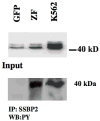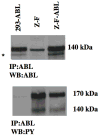Phosphorylation of the SSBP2 and ABL proteins by the ZNF198-FGFR1 fusion kinase seen in atypical myeloproliferative disorders as revealed by phosphopeptide-specific MS
- PMID: 19658100
- PMCID: PMC2996822
- DOI: 10.1002/pmic.200800852
Phosphorylation of the SSBP2 and ABL proteins by the ZNF198-FGFR1 fusion kinase seen in atypical myeloproliferative disorders as revealed by phosphopeptide-specific MS
Erratum in
- Proteomics. 2009 Nov;9(21):5001. Natarajan, Lalitha [corrected to Nagarajan, Lalitha]
Abstract
The ZNF198-fibroblast growth factor receptor-1 (FGFR1) fusion kinase is a constitutively activated tyrosine kinase associated with a specific atypical myeloproliferative disease. The chimeric protein localizes to the cytoplasm, unlike the wild type FGFR1 receptor kinase, and presumably inappropriately phosphorylates specific targets as part of the oncogenic signaling cascade. Other than known targets of the FGFR1 kinase itself, few specific targets of ZNF198-FGFR1 have been identified. Using a genetically engineered HEK 293 cell system, we have identified proteins that are specifically phosphorylated in the presence of the fusion kinase using anti-phosphotyrosine immunoprecipitation and MS. Compared with 293 cells expressing exongenous wild type FGFR1, ZNF198-FGFR1 is associated with phosphorylation of several proteins including SSBP2, ABL, FLJ14235, CALM and TRIM4 proteins. The specificity of the phosphorylation events in the SSBP2 and ABL proteins, which have previously been implicated in leukemogenesis, was further confirmed independently using immunoprecipitation with protein-specific antibodies and Western blotting. The MS analysis also identified the phosphorylation events in the ZNF198 moiety in the chimeric protein that might be related to its function. These studies identify the intersection of several different leukemia-related pathways in the development of this myeloproliferative disorder and provide new insights into the substrates of FGFR1 under defined conditions.
Figures


Similar articles
-
ZNF198, a zinc finger protein rearranged in myeloproliferative disease, localizes to the PML nuclear bodies and interacts with SUMO-1 and PML.Exp Cell Res. 2006 Nov 15;312(19):3739-51. doi: 10.1016/j.yexcr.2006.06.037. Epub 2006 Aug 14. Exp Cell Res. 2006. PMID: 17027752
-
Induction of the plasminogen activator inhibitor-2 in cells expressing the ZNF198/FGFR1 fusion kinase that is involved in atypical myeloproliferative disease.Blood. 2006 May 1;107(9):3693-9. doi: 10.1182/blood-2005-04-1505. Epub 2006 Jan 12. Blood. 2006. PMID: 16410451 Free PMC article.
-
ZNF198-FGFR1 transforms Ba/F3 cells to growth factor independence and results in high level tyrosine phosphorylation of STATS 1 and 5.Neoplasia. 1999 Oct;1(4):349-55. doi: 10.1038/sj.neo.7900035. Neoplasia. 1999. PMID: 10935490 Free PMC article.
-
Molecular drug targets in myeloproliferative neoplasms: mutant ABL1, JAK2, MPL, KIT, PDGFRA, PDGFRB and FGFR1.J Cell Mol Med. 2009 Feb;13(2):215-37. doi: 10.1111/j.1582-4934.2008.00559.x. Epub 2008 Oct 23. J Cell Mol Med. 2009. PMID: 19175693 Free PMC article. Review.
-
Common features of myeloproliferative disorders with t(8;9)(p12;q33) and CEP110-FGFR1 fusion: report of a new case and review of the literature.Leuk Res. 2008 Aug;32(8):1304-8. doi: 10.1016/j.leukres.2007.11.012. Epub 2007 Dec 21. Leuk Res. 2008. PMID: 18096225 Review.
Cited by
-
YB-1 as an Oncoprotein: Functions, Regulation, Post-Translational Modifications, and Targeted Therapy.Cells. 2022 Apr 4;11(7):1217. doi: 10.3390/cells11071217. Cells. 2022. PMID: 35406781 Free PMC article. Review.
-
Why and how to investigate the role of protein phosphorylation in ZIP and ZnT zinc transporter activity and regulation.Cell Mol Life Sci. 2020 Aug;77(16):3085-3102. doi: 10.1007/s00018-020-03473-3. Epub 2020 Feb 19. Cell Mol Life Sci. 2020. PMID: 32076742 Free PMC article. Review.
-
Biological and clinical implications of FGFR aberrations in paediatric and young adult cancers.Oncogene. 2023 Jun;42(23):1875-1888. doi: 10.1038/s41388-023-02705-7. Epub 2023 May 2. Oncogene. 2023. PMID: 37130917 Free PMC article. Review.
-
YBX1: A Multifunctional Protein in Senescence and Immune Regulation.Curr Issues Mol Biol. 2024 Dec 13;46(12):14058-14079. doi: 10.3390/cimb46120841. Curr Issues Mol Biol. 2024. PMID: 39727969 Free PMC article. Review.
-
Role of post-translational modification of the Y box binding protein 1 in human cancers.Genes Dis. 2015 May 27;2(3):240-246. doi: 10.1016/j.gendis.2015.05.001. eCollection 2015 Sep. Genes Dis. 2015. PMID: 30258867 Free PMC article. Review.
References
-
- Xiao S, Nalabolu SR, Aster JC, Ma JL, Abruzzo L, Jaffe ES, Stone R, Weissman SM, Hudson TJ, Fletcher JA. FGFR1 is fused with a novel zinc-finger gene, ZNF198, in the t(8;13) leukaemia/lymphoma syndrome. Nature Genetics. 1998;18:84–87. - PubMed
-
- Still IH, Cowell JK. The t(8;13) atypical myeloproliferative disorder: further analysis of the ZNF198 gene and lack of evidence for multiple genes disrupted on chromosome 13. Blood. 1998;92:1456–1458. - PubMed
-
- Smedley D, Hamoudi R, Clark J, Warren W, Abdul-Rauf M, Somers G, Venter D, Fagan K, Cooper C, Shipley J. The t(8;3)(p11;q11–12) rearrangement associated with an atypical myeloproliferative disorder fuses the fibroblast growth factor receptor 1 gene to a novel gene RAMP. Human Molecular Genetics. 1998;7:637–642. - PubMed
-
- Popovici C, Adelaide J, Ollendorff V, Chaffanet M, Guasch G, Jacrot M, Leroux D, Birnbaum D, Pebusque MJ. Fibroblast growth factor receptor 1 is used to FIM in stem-cell myeloproliferative disorder with t(8;13)(p12;q12) Proceedings of the National Academy of Sciences of the United States of America. 1998;95:5712–5717. - PMC - PubMed
-
- Abruzzo LV, Jaffe ES, Cotelingam JD, Whangpeng J, Delduca V, Medeiros LJ. T-Cell Lymphoblastic Lymphoma with Eosinophilia Associated with Subsequent Myeloid Malignancy. American Journal of Surgical Pathology. 1992;16:236–245. - PubMed
Publication types
MeSH terms
Substances
Grants and funding
LinkOut - more resources
Full Text Sources
Molecular Biology Databases
Miscellaneous

